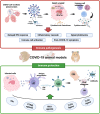Immunobiology of COVID-19: Mechanistic and therapeutic insights from animal models
- PMID: 38894519
- PMCID: PMC11298684
- DOI: 10.24272/j.issn.2095-8137.2024.062
Immunobiology of COVID-19: Mechanistic and therapeutic insights from animal models
Abstract
The distribution of the immune system throughout the body complicates in vitro assessments of coronavirus disease 2019 (COVID-19) immunobiology, often resulting in a lack of reproducibility when extrapolated to the whole organism. Consequently, developing animal models is imperative for a comprehensive understanding of the pathology and immunology of severe acute respiratory syndrome coronavirus 2 (SARS-CoV-2) infection. This review summarizes current progress related to COVID-19 animal models, including non-human primates (NHPs), mice, and hamsters, with a focus on their roles in exploring the mechanisms of immunopathology, immune protection, and long-term effects of SARS-CoV-2 infection, as well as their application in immunoprevention and immunotherapy of SARS-CoV-2 infection. Differences among these animal models and their specific applications are also highlighted, as no single model can fully encapsulate all aspects of COVID-19. To effectively address the challenges posed by COVID-19, it is essential to select appropriate animal models that can accurately replicate both fatal and non-fatal infections with varying courses and severities. Optimizing animal model libraries and associated research tools is key to resolving the global COVID-19 pandemic, serving as a robust resource for future emerging infectious diseases.
由于免疫系统在体内分布复杂,体外实验在评估新型冠状病毒肺炎(COVID-19)的免疫生物学时可重复性差,并难以将推广至整个机体。因此,迫切需要建立动物模型,全面了解新型冠状病毒(SARS-CoV-2)感染的免疫学和病理学机制。该文综述了当前COVID-19动物模型的最新进展,主要包括非人灵长类动物、小鼠和仓鼠;阐明这些动物模型揭示的SARS-CoV-2感染的免疫病理机制、免疫保护作用和长期影响,以及它们在SARS-CoV-2感染的免疫预防和免疫治疗方面的应用。我们强调不同动物模型之间存在差异及其适用范围,因为没有一种模型能够完全涵盖COVID-19的所有方面。为了应对COVID-19的多样性威胁,我们指出选择合适的动物模型对准确地模拟致命或非致命感染的疾病特征是至关重要的。优化现有动物模型库并开发相关研究工具是解决全球COVID-19大流行挑战的关键,也是为应对未来新发传染性流行奠定坚实基础。.
Keywords: Animal models; COVID-19; Immunotherapy; Infection immunology; SARS-CoV-2.
Conflict of interest statement
The authors declare that they have no competing interests.
Figures
Similar articles
-
A Comprehensive Review of Animal Models for Coronaviruses: SARS-CoV-2, SARS-CoV, and MERS-CoV.Virol Sin. 2020 Jun;35(3):290-304. doi: 10.1007/s12250-020-00252-z. Epub 2020 Jun 30. Virol Sin. 2020. PMID: 32607866 Free PMC article. Review.
-
Of Mice and Men: The Coronavirus MHV and Mouse Models as a Translational Approach to Understand SARS-CoV-2.Viruses. 2020 Aug 12;12(8):880. doi: 10.3390/v12080880. Viruses. 2020. PMID: 32806708 Free PMC article. Review.
-
Evaluation of the susceptibility of mice & hamsters to SARS-CoV-2 infection.Indian J Med Res. 2020 May;151(5):479-482. doi: 10.4103/ijmr.IJMR_2235_20. Indian J Med Res. 2020. PMID: 32611917 Free PMC article. No abstract available.
-
A perspective on potential antibody-dependent enhancement of SARS-CoV-2.Nature. 2020 Aug;584(7821):353-363. doi: 10.1038/s41586-020-2538-8. Epub 2020 Jul 13. Nature. 2020. PMID: 32659783
-
Consensus summary report for CEPI/BC March 12-13, 2020 meeting: Assessment of risk of disease enhancement with COVID-19 vaccines.Vaccine. 2020 Jun 26;38(31):4783-4791. doi: 10.1016/j.vaccine.2020.05.064. Epub 2020 May 25. Vaccine. 2020. PMID: 32507409 Free PMC article.
Cited by
-
Bat-derived oligopeptide LE6 inhibits the contact-kinin pathway and harbors anti-thromboinflammation and stroke potential.Zool Res. 2024 Sep 18;45(5):1001-1012. doi: 10.24272/j.issn.2095-8137.2023.372. Zool Res. 2024. PMID: 39147715 Free PMC article.
References
-
-
Afkhami S, D’Agostino MR, Zhang AL, et al. 2022. Respiratory mucosal delivery of next-generation COVID-19 vaccine provides robust protection against both ancestral and variant strains of SARS-CoV-2.
Cell ,185 (5): 896–915. e19.
-
Publication types
MeSH terms
Grants and funding
LinkOut - more resources
Full Text Sources
Medical
Miscellaneous



